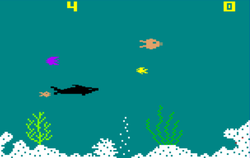
Shark! Shark!
Encyclopedia

Intellivision
The Intellivision is a video game console released by Mattel in 1979. Development of the console began in 1978, less than a year after the introduction of its main competitor, the Atari 2600. The word intellivision is a portmanteau of "intelligent television"...
game originally designed by Don Daglow
Don Daglow
Don Daglow is an American computer game and video game designer, programmer and producer. He is best known for designing a series of pioneering simulation games and role-playing games, as well as the first computer baseball game and the first graphical MMORPG, all between 1971 and 1995...
, and with additional design and programming by Ji-Wen Tsao, one of the first female game programmers in the history of video games. The player is a fish who must eat smaller fish in order to gain points and extra lives while avoiding enemies such as larger fish, sharks, jellyfish, lobsters and crabs. After eating a certain number of fish, the player's fish grows in size and is thus able to eat a larger selection of fish. However, while the larger fish becomes a bit faster, he is less agile than the small fish and has a harder time avoiding enemies. As the game player continues to amass points by eating smaller fish, or killing the shark with multiple bites to his tail, the shark becomes increasingly faster, and eventually, invulnerable jellyfish are added to the mix which makes the game considerably more difficult. At 100,000 points, the shark becomes super fast, and even the best players' fish die at alarming rates, often finding themselves slamming headlong into jellyfish or larger fish in their mad flight away from the deadly shark.
Shark! Shark! was originally considered by Mattel to be a cute game for kids and unlikely to make strong inroads into the gaming community. However, the market caught Mattel unprepared when it fully embraced the game as a sorely needed Intellivision original. The game's popularity skyrocketed, forcing Mattel to quickly manufacture another batch of cartridges. The original cartridge run was only 5,600 units.
Ports
Shark! Shark! was made available on Microsoft'sMicrosoft
Microsoft Corporation is an American public multinational corporation headquartered in Redmond, Washington, USA that develops, manufactures, licenses, and supports a wide range of products and services predominantly related to computing through its various product divisions...
Game Room
Game Room
Game Room is a gaming service for the Xbox 360 video game system, Microsoft Windows PCs, and Windows Phone 7. Launched on March 24, 2010, Game Room lets players download classic video games and compete against each other for high scores...
service for its Xbox 360
Xbox 360
The Xbox 360 is the second video game console produced by Microsoft and the successor to the Xbox. The Xbox 360 competes with Sony's PlayStation 3 and Nintendo's Wii as part of the seventh generation of video game consoles...
console and for Windows-based
Microsoft Windows
Microsoft Windows is a series of operating systems produced by Microsoft.Microsoft introduced an operating environment named Windows on November 20, 1985 as an add-on to MS-DOS in response to the growing interest in graphical user interfaces . Microsoft Windows came to dominate the world's personal...
PC
Personal computer
A personal computer is any general-purpose computer whose size, capabilities, and original sales price make it useful for individuals, and which is intended to be operated directly by an end-user with no intervening computer operator...
s in May 2010.
Bugs
The bubble sound effects do not work correctly on the Intellivision II. The game is otherwise playable. This bug does not impact the original Intellivision console.Occasionally, when pressing the sprint button, the player's fish will go in the opposite direction from that instructed--usually with disastrous results.

